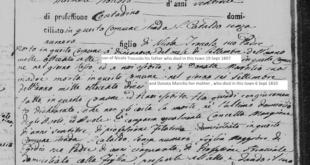Italian Linking Verb
Essere
“To be, or not to be…” is one of the most famous lines ever written in the English language. But that phrase would not be possible without a verb to express the very idea that we exist. Think of how many times a day we say, “I am” or “he is” or “we are” — all forms of the English infinitive verb “to be.”
In Italian, the verb essere means to be. Essere in the present tense is a linking verb, as it connects the subject in the beginning of the sentence with specific information about the subject at the end of the sentence. No action is described. Instead, with the verb essere, the subject can be thought of as one and the same as, or “linked” to the information that follows.
The complete conjugation of essere in the present tense is given below. Note that essere is an irregular verb and all forms should be memorized given the daily use you will have for this verb! The accented syllables have been underlined.
| io | sono | I am |
| tu | sei | you (familiar) are |
| Lei
lei/lui |
è | you (polite)are
she/he is |
| noi | siamo | we are |
| voi | siete | you all are |
| loro | sono | they are |
Since a linking verb “links” the subject to a descriptor, there are special rules to follow when a verb like “to be” or “essere” is employed. Since the subject in the first phrase and the predicate that follows are “linked” they are essentially “one and the same.” Therefore, the verb tense, as well as the noun and/or adjective that follows, must always agree with the subject. This situation has special implications for Italian, which classifies all nouns into masculine and feminine and requires that all adjectives match their noun in gender and number!
The use of essere requires
the Italian endings for any noun or adjective that follows
to match the gender and number of the subject.
They are, after all, one and the same!
Essere is also an essential “helping verb” for compound tenses in Italian, which are made up of more than one verb. Hence essere is also classified as an auxiliary, or “assisting” verb when used in this manner. For compound tenses, essere requires a change in the ending of the verb that it assists. The passato prossimo, which is used to describe the recent past in Italian (and has been discussed in other blogs in this series), is an example of how essere is used as an auxiliary verb. Now that we know that essere is a linking verb, it makes sense that the ending of the past participle that follows the conjugated form of essere must be changed!
Let’s go through some simple examples in the present tense to see how this works.
The sentences below use the nouns that refer to a young girl, a young boy, and the different groups to which girls and boys can belong. For these nouns, one can simply change the ending of ragazzo (boy) to reflect the gender and number of the subject. Remember that in a group of males, or males and females, the Italian ending defaults to the masculine -i. A group of all females is special, though; the plural feminine ending -e is used.
The descriptor used in the sentences below, is the adjective bravo (good/nice personality), which will change it’s ending to reflect the gender and number of the noun that it modifies.
Both noun and adjective will, of course, reflect back to the subject
when using the verb to be, which is essere in Italian.
In the examples below, the gender of the subject and the noun and adjective endings that match it are given in red for the feminine and brown for the masculine. The conjugated forms of essere are green.
Caterina è una brava ragazza. Kathy is a good/nice girl.
Pietro è un bravo ragazzo. Peter is a good/nice boy.
Caterina e Francesca sono brave ragazze. Kathy and Frances are good girls.
Pietro e Michele sono bravi ragazzi. Peter and Michael are good boys.
Caterina e Pietro sono bravi ragazzi. Kathy and Peter are good young people.
What do we do if the noun after the verb to be (essere) is omitted from the sentence and only an adjective is used to describe the subject? Simply remember to change the ending of the adjective to reflect the gender and number of the subject.
Caterina è brava. Kathy is good/nice.
Pietro è bravo. Peter is good/nice.
Caterina e Francesca sono brave. Kathy and Frances are good.
Pietro e Michele sono bravi. Peter and Michael are good.
Caterina e Pietro sono bravi. Kathy and Peter are good.
One last word on the use of bravo. If you shout, “Bravo!” in a theater, this is for a single male performer. Shout “Brava!” for a female performer. “Bravi!” is correct for the entire cast but for some reason is less frequently used than “Bravo!” here in America.
Italian Linking Verb
Diventare
The Italian verb diventare (to become), like the verb “to be,” always functions as a linking verb in both Italian and English. By definition, the subject “becomes” what is listed in the phrase that follows this verb. Although the subject changes, the verb still refers to the subject mentioned at the beginning of the sentence.
Diventare is a regular -are verb. The full conjugation is below.
| io | divento | I become |
| tu | diventi | you (familiar) become |
| Lei
lei/lui |
diventa | you (polite) become
she/he becomes |
| noi | diventiamo | we become |
| voi | diventate | you all become |
| loro | diventano | they become |
Notice that if we substitute the conjugated form of diventare for essere in our example sentences in the first section of this blog, the endings for the adjective bravo remain the same! I’ve added a qualifier to the first sentence, which can also be used with the sentences that follow with our verb diventare.
Caterina diventa brava con la prova. Kathy becomes good with rehearsing.
Pietro diventa bravo. Peter becomes good.
Caterina e Francesca diventano brave. Kathy and Frances become good.
Pietro e Michele diventano bravi. Peter and Michael become good.
Caterina e Pietro diventano bravi. Kathy and Peter become good.
Since the verb diventare is often used in the past tense, such as when one is talking about a change they have noticed in another, let’s try these sentences one more time with the passato prossimo. Essere must be conjugated and used as the helping verb with diventare, as with other Italian verbs that denote a change in one’s state of being.
In the examples below, notice the change in the ending of the past participle diventato to match the gender and number of the subject. Also, the addition of a specific time frame to the first sentence (which can be used with the remaining sentences as well) to go along with our use of the passato prossimo. (If you need a refresher on how to use the passato prossimo, visit the Fra Noi blog “Italian Past: Avere or Essere?”)
Caterina è diventata brava lo scorso anno. Kathy became good last year.
Pietro è diventato bravo. Peter became good.
Caterina e Francesca sono diventate brave. Kathy and Frances became good.
Pietro e Michele sono diventati bravi. Peter and Michael become good.
Caterina e Pietro sono diventati bravi. Kathy and Peter became good.
Many common Italian phrases that speak of life changes use the verb diventare. One can make something of themselves, become a grandfather, or become another’s friend and these ideas can be rendered with phrases that use the Italian verb diventare.
See below for example sentences that describe real life situations with diventare. Once again, notice that the passato prossimo and the noun or adjective that follows all must change to agree in gender and number with the subject!
Marco è diventato qualcuno quando lui ha compiuto trentadue anni.
Mark made something of himself when he became 32 years old.
Michelle è diventato nonno alla età di sessanta anni.
Michael became a grandfather at the age of 60.
Maria e Anna sono diventate amiche. Mary and Ann have become friends.
Marco e Michelle sono diventati amici. Mark and Michael have become friends.
Marco e Anna sono diventati amici. Mark and Ann have become friends.
Several Italian expressions use diventare to refer to emotions that show in a person’s facial expressions or body language. For instance, the act of blushing, showing confusion, freezing up or becoming furious.
| diventare di fuoco | to blush violently |
| diventare rosso come un peperone | to blush to become bright red like a pepper |
| diventare rosso come un tacchino | to blush
to become red like a turkey |
| diventare di mille colori diventare di tutti i colori |
to blush a million shades of color to show awkwardness and confusion on one’s face. |
| diventare una bestia | to become furious/ to lose it. |
| diventare di gelo | to freeze up |
Maria è diventata di fuoco quando ho detto che a Marco gli piace lei.
Maria blushed violently when I told her that Mark likes her.
Pietro è diventato una bestia* dopo aver guidato nel traffico per due ore.
Peter lost it after driving in traffic for two hours.
Maria e Pietro sono diventati di gelo quando hanno sentito un rumore in casa di notte.
Mary and Peter froze up when they heard noise in the house at night.
*The noun bestia is always feminine.
Italian Linking Verb
Sembrare
The Italian verb sembrare (to seem/to appear/to look like) is the third verb that always functions as a linking verb in both Italian and English.* By definition, the subject “seems to be “or “looks like” what is listed in the phrase that follows sembrare. Although, in reality the subject may not fit the description in the phrase that follows, sembrare still refers back to the subject. and therefore is a linking verb.
Sembrare is a regular -are verb. The full conjugation is below.
| io | sembro | I seem I look like |
| tu | sembri | you (familiar)seem you look like |
| Lei
lei/lui |
sembra | you (polite) seem you look likeshe/he seems she/he looks like |
| noi | sembriamo | we seem we look like |
| voi | sembrate | you all seem you all look like |
| loro | sembrano | they seem they look like |
*Sembrare can also mean “to feel like” but this definition is not discussed here.
Notice that if we substitute the conjugated form of sembrare for essere in our example sentences in the first section of this blog, the endings for the adjective bravo remain the same! I’ve translated bravo as nice, as in to have a nice personality, for the examples below that use sembrare.
Caterina sembra brava. Kathy seems nice.
Pietro sembra bravo. Peter seems nice.
Caterina e Francesca sembrano brave. Kathy and Frances seem nice.
Pietro e Michele sembrano bravi. Peter and Michael seem nice.
Caterina e Pietro sembrano bravi. Kathy and Peter seem nice.
In life, sembrare is commonly used to describe how a person comes across, or presents him or herself, as above. Just replace bravo with any one of many characteristics or personality types to create many more descriptive sentences.
Lei sembra intelligente, contenta, bella, etc.
She seems intelligent, happy, pretty, etc.
Or, on the negative side…
Lei sembra maleducata, triste, brutta, etc.
She seems rude, sad, ugly, etc.
How to Choose Italian Verbs
Sembrare vs. Somigliare
Sembrare is also often the verb used to describe when someone resembles, or “looks like” someone else, such as when a child looks like their parent or when someone you know resembles a famous actor. Notice that in this case the idea contained in the English phrase “looks like” is expressed with sembrare alone in Italian; no preposition or other clarifying word is needed.
The verb somigliare, followed by the preposition a, is often used in this situation as well. Since the two people or groups are similar to each other, it stands to reason they will be equivalent in gender and number. In the passato prossimo, though, sembrare uses essere as its helping verb, while somigliare uses avere.
If you want to embellish your statement, provide specific characteristics using either entrambe for a feminine comparison, or entrambi for a masculine comparison or a comparison of a group of males and females.
Maria sembra sua mamma; Maria looks like her mother;
entrambe sono alte e belle. both are tall and beautiful.
– or –
Maria somiglia a sua mamma. Maria looks like her mother.
entrambe sono alte e belle. both are tall and beautiful.
Pietro sembra Marcello Mastroianni; Peter looks like Marcello Mastroianni;
entrambi sono alti e belli. both are tall and handsome.
– or –
Pietro somiglia a Marcello Mastroianni. Maria looks like Marcello Mastroianni.
entrambi sono alti e belli. both are tall and handsome.
A place or object can also look similar to another place or object, depending on one’s perspective. Be careful when stating your opinion, though, since the sentence structure may require use of the subjunctive mood! If you are not familiar with the subjunctive mood but still want to emphasize that you are uncertain or stating an opinion, start your sentence with one of the following phrases: forse (perhaps), per me (for me), or secondo me (according to me). These three phrases do not require the use of a subjunctive mood verb.*
Secondo me, Roma sembra New York: According to me, Rome seems like New York;
entrambe (città) sono rumorose e pieno di gente. both (cities) are noisy and full of people.
– or –
Per me, Roma somiglia a New York: For me, Rome is similar to New York;
entrambe (città) sono rumorose e pieno di gente. both (cities) are noisy and full of people.
La nuova versione del software sembra la vecchia; The new version of the software appears like the
old;
non ho notato alcuna differenza. I haven’t noticed any difference.
– or –
La nuova versione del software somoglia alla vecchia; The new version of the software seems like the old;
Non ho notato qualunque differenza. I haven’t noticed any difference.
*If you are interested in learning more about the subjunctive mood, visit my blog series “Speak Italian!” on this topic in my blog.learntravelitalian.com. The first blog in the series is Italian Subjunctive (Part 1): Speak Italian!
Remember how to use the Italian linking verbs
Essere, Diventare, and Sembrare
and I guarantee you will use them every day!
For “All the Italian you need to enjoy your trip to Italy” click on the links for my Conversational Italian for Travelers books -Kathryn Occhipinti


 Fra Noi Embrace Your Inner Italian
Fra Noi Embrace Your Inner Italian






